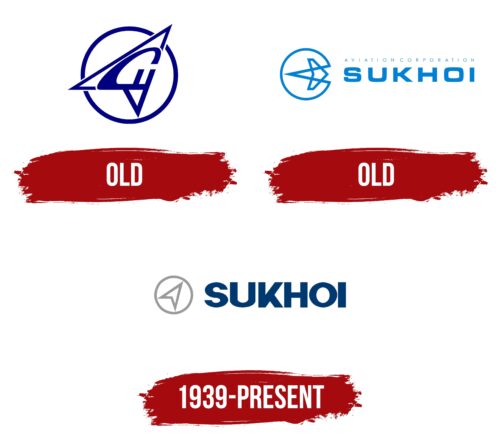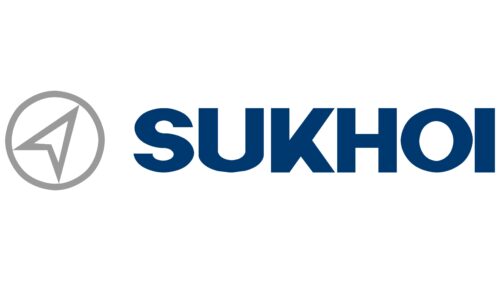The Sukhoi logo is too standardized and indistinguishable from other aviation brands. The emblem does not sufficiently reflect the advanced technologies and engineering solutions crucial for the aircraft manufacturer.
Sukhoi: Brand overview
Sukhoi, the illustrious Russian aircraft manufacturer, was born in 1939 and carries the legacy of its founder, the visionary Pavel Osipovich Sukhoi. On July 29, 1939, the USSR’s People’s Commissariat of Aviation Industry officially established the Experimental Design Bureau (OKB) under Sukhoi’s guidance.
This bureau’s debut project was the Su-2 bomber, which rolled off the production line in 1940 and became a crucial asset in the initial phases of the Great Patriotic War. In the post-war era, the team shifted focus towards jet fighters, introducing the Su-17 in 1949, notable for its swept-wing design—a first for Soviet aviation.
Entering the 1950s, the bureau ventured into various experimental aircraft, leading to the development of the Su-7 supersonic fighter, which set the stage for a new lineage of combat planes. The 1960s saw the creation of the Su-17 fighter-bomber with variable-sweep wings, a groundbreaking addition to Soviet military aviation.
The 1970s witnessed the birth of two iconic aircraft: the Su-25 ground-attack plane and the Su-27 air superiority fighter. The Su-27, in particular, became a cornerstone of Soviet and later Russian air forces. After Pavel Sukhoi’s passing in 1975, leadership passed to Yevgeny Ivanov and Mikhail Simonov, under whose direction the bureau continued to innovate.
During the 1980s and 1990s, the Su-27 family expanded, introducing variants like the carrier-based Su-33 and the multirole Su-30. 1983, the bureau received the Order of Lenin, recognizing its significant contributions to aviation technology.
Post-Soviet Union dissolution in 1991, the company faced challenges due to reduced defense orders but managed to preserve its capabilities. The 2000s marked a new chapter as the brand ventured into civilian aviation with the Sukhoi Superjet 100 regional airliner project, initiated in 2000.
In 2006, the company integrated into the United Aircraft Corporation (UAC), which was part of Russia’s aviation industry consolidation efforts. The Sukhoi Superjet 100 took its maiden flight in 2008, heralding its foray into the commercial aviation market.
The next major milestone was the delivery of the Su-35 fighter in 2010, an advanced evolution of the Su-27. The Sukhoi Superjet 100 entered commercial service in 2011, further solidifying the company’s presence in civil aviation.
In 2019, the cutting-edge Su-57 fifth-generation fighter jet took its first flight, representing the pinnacle of the firm’s technological advancements. Throughout its history, the aviation firm has exported its aircraft worldwide, cementing its status as a global leader in military aviation while making significant strides in the civilian aircraft market.
Meaning and History
What is Sukhoi?
This Russian aerospace company is known for its innovative military and civil aviation developments. It stands out for creating the legendary Su series fighters, a symbol of Russian military strength exported to many countries worldwide. The company is known for its Sukhoi Superjet 100 project, the first Russian next-generation passenger aircraft.
Old
Sukhoi, the company producing all Russian military aircraft under the Su brand, lacks originality in its choice of emblems. Its old logo resembles an arrow pointing to the upper right corner. It is supposed to be a stylized image of a fighter jet, but the designers failed to convey the intended idea. What should look like an aircraft appears exactly like a mouse cursor. This creates inappropriate associations with computer technology and the IT sector.
Behind the cursor is a white circle with a blue outline. The creators intended it to symbolize the globe, but they did not succeed in realizing this concept. Instead, they produced a chaotic jumble of geometric shapes that visually weighed down the emblem, making it appear dragged downward. This poorly represents the company’s field of activity.
Another misstep was the attempt to combine the arrow with the inscription “Су” – the name of Sukhoi’s main line of military aircraft. The monogram is located in the center of the circle and more closely resembles the English letter “G,” which has no connection to the brand. The lower part of the “у” merges with the arrow, resulting in an awkwardly pointed shape. The abundance of sharp angles conveys an aggressiveness associated with a company that produces fighter jets.
Old
This is another Sukhoi logo that serves as an example of unsuccessful branding. The designers aimed to depict a flying aircraft and, for some reason, combined it with a circle split into two halves. This creates the impression that the famous Japanese character Pac-Man is eating a boomerang—or, more precisely, a stylized fighter jet. Such an arrangement of elements forms a poor impression of the brand and subconsciously hints at the aircraft’s imperfection. This is an unfortunate choice for a manufacturer targeting the international market.
The designers had to add text to the drawing to link the emblem to the brand it represents. They placed the phrase “AVIATION CORPORATION SUKHOI” in two levels and combined completely dissimilar fonts: a standard thin grotesque and a geometric, rectangular-shaped font. This creates a visual contrast that enhances the logo’s chaotic nature.
The chosen style does not align with the field of an aviation company, as it appears poorly thought out and disorderly. The color scheme poorly reflects Sukhoi’s concept. Sky blue is usually associated with calmness, healing, and peace, while white is associated with purity and harmony. These qualities are not characteristic of a manufacturer of Su brand military aircraft.
1939 – today
The company’s most well-known logo features its name written in large, dark blue letters on a white background. The word appears unbalanced for two reasons:
- The uneven spacing between letters – the gap between “U” and “K” is wider than between “O” and “I”;
- The glyphs’ disharmonious shape makes the inscription’s lower parteem visually heavy.
The designers used a contrasting font to draw attention to the inscription. Usually, varying stroke thickness creates a sense of lightness and flight, but not in this case. Due to the lack of balance, the brand name appears unclear and inconsistent.
The Sukhoi symbol, a small white mouse cursor, creates a completely different impression. Unlike the wordmark, it does not seem heavy. On the contrary, it exudes a sense of emptiness, creating a feeling of incompleteness, as if the emblem is missing an important detail. The arrow is supposed to represent a Russian fighter jet, but the designers failed to convey this idea accurately.
The cursor is placed within a white circle with a gray outline. This color scheme evokes a sense of boredom and monotony, which negatively impacts the company’s image. The shape of the arrow fits Sukhoi’s field of activity perfectly. The sharp angles emphasize the danger and aggression associated with military aircraft.







